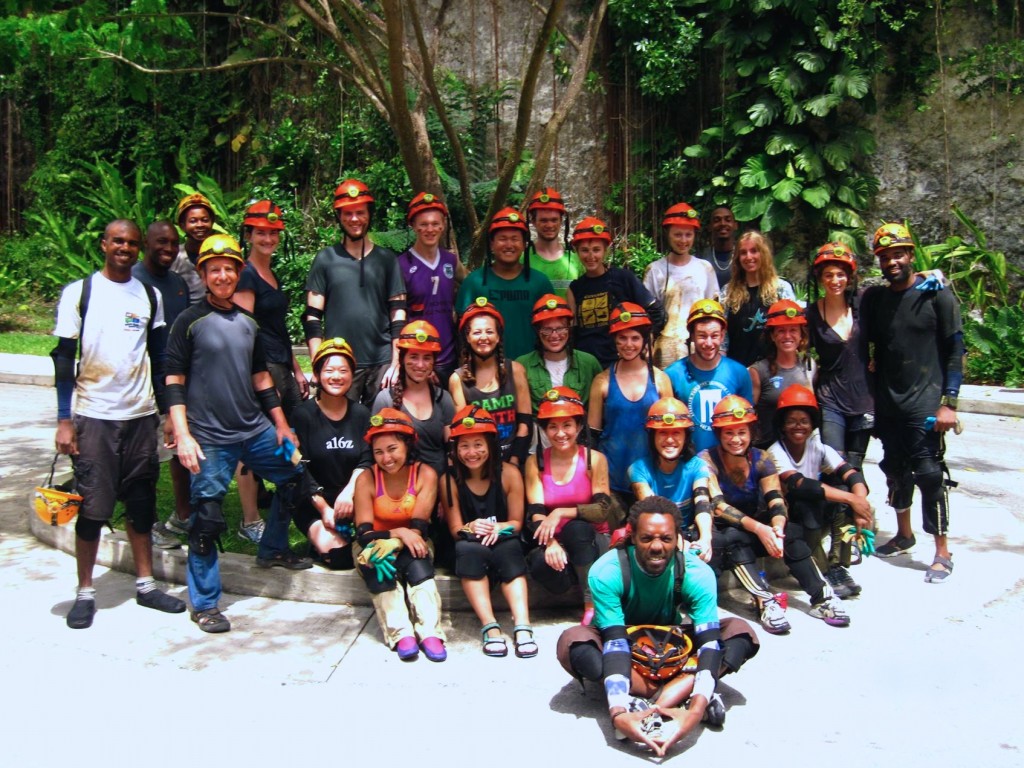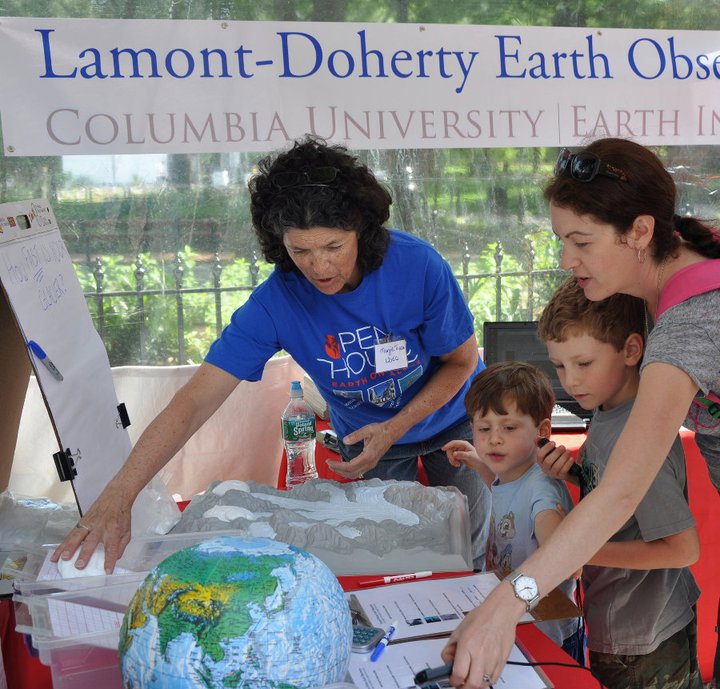Education
Education is central to the mission of Lamont-Doherty Earth Observatory. Our scientists bring innovation and leadership into formal and informal learning settings through the Observatory’s commitment to Science, Technology, Mathematics and Engineering (STEM) education. Our scientists teach students and inform the general public about the Earth; about its ocean, atmosphere and biosphere; about the hazards posed by natural phenomena such as earthquakes and climate fluctuations; and about the ways by which human beings are contributing to changes in the environment.
Each year, numerous students and teachers participate in hands-on, Earth science research opportunities. From our long-running summer intern program, to our top-ranked Department of Earth and Environmental Sciences, Lamont researchers lead the way in engaging learners of all ages in science.

Geochemist Steve Goldstein and a group of Columbia University undergraduates spent spring break in Barbados studying the fossil coral reefs fringing the island. Students examined the magnificent reefs both on dry land and underwater, and considered how evolving knowledge of natural climate cycles plays a key role in understanding modern climate change.
Department of Earth and Environmental Sciences
Much of our formal education is taught through the Department of Earth and Environmental Sciences (DEES), which is distinguished as having the best Earth science Ph.D. program in the country, a ranking that reflects Lamont’s exceptional people, resources and affiliated programs. The bright students in DEES bring enthusiasm and innovative ideas, lend fresh energy to our current investigations and shape the directions of our future research.
In the fall, DEES welcomed 19 new graduate students. They came from seventeen institutions and five different nations and populated each of the five research divisions at Lamont. Three of these incoming graduate students and five of Lamont’s current graduate students were named recipients of National Science Foundation Graduate Research Fellowships: Natalie Accardo, Weston Anderson, Logan Brenner, Kassandra Costa, Sam Phelps, Hannah Rabinowitz, Michael Sandstrom and Sebastian Vivancos. The fellowship program recognizes and supports outstanding graduate students who are pursuing research-based masters and doctoral degrees. Fellows benefit from a three-year annual stipend, along with an education allowance for tuition and fees and opportunities for international research and professional development.
Two more of our current graduate students, Julius Busecke and Nandini Ramesh, received NASA Earth and Space Science Fellowships (NESSF). The purpose of the NESSF fellowships is to ensure continued training of a highly qualified workforce in disciplines needed to achieve NASA’s scientific goals.
Lamont Summer Intern Program
Over the course of its 30-year existence, Lamont’s Summer Intern Program has brought to Lamont more than 590 undergraduates from a broad spectrum of scientific disciplines to work with our scientists. The program provides students hands-on research experience, first-class mentoring, exposure to professional scientists and opportunities for participants to continue working with Lamont researchers once the 10-week program concludes. Many Summer Intern Program participants go on to become scientists, and some even return to Lamont as graduate students and postdoctoral researchers.
Oceanographer Dallas Abbott, who directs the program each summer, believes that the Lamont program is unique. The variety of Earth science research that takes place on campus exposes students to the vastness of the field. “Sometimes the interns discover that what interests them most is not what they did as a research project but what one of the other students did. They comprehend the multitude of scientific questions that still remain unsolved.”
Recognizing Excellence in Teaching and Mentoring
A local non-profit organization, Keep Rockland Beautiful, named Lamont education coordinator Margie Turrin the recipient of their 2013 Education Award. “Margie is an extraordinary educator who has brought engaging, experiential learning to thousands of students throughout Rockland” and “her leadership continues to support a cleaner, more environmentally sound Rockland County,” reads the award citation. A member of our Polar Geophysics group, Turrin is active in a wide range of environmental education activities for teachers and students and frequently blogs about her fieldwork experiences in the Polar Regions.

Lamont Education Coordinator Margie Turrin works with young science enthusiasts at New York City’s World Science Festival.
Shaking Up Seismology with Sight and Sound
Geophysicist Ben Holtzman grew up discovering science through interactive exhibits in San Francisco’s Exploratorium and now provides a similar experience for others. Holtzman designs immersive shows that allow people to experience what earthquakes and seismic waves look and sound like as they move through and around the Earth. In June, Holtzman and his collaborators presented the first of these shows, SeismoDome: Sights and Sounds of Global Seismology, at the American Museum of Natural History.
Holtzman is also a musician and plays in a band with Jason Candler, a sound artist and Holtzman’s SeismoDome collaborator. With help from additional collaborators ranging from seismologists to computer musicians to astrophysicists, the two produced an audio and visual narrative of five of the world’s recent large earthquakes. The SeismoDome audience experiences these events from the perspective of being out in space and then deep inside the planet.
“One of the most fundamental ideas that most people don’t know and everybody understands when they leave the show is that an earthquake, if it’s big enough, sends waves throughout the entire planet. That’s just a very simple idea to grasp when you see it and hear it,” says Holtzman.
In addition to providing an awe-inspiring experience, Holtzman hopes that people will leave Seismodome realizing that earthquakes are a constant natural process, like weather, and there’s nothing inherently bad about them. “We always say in these exhibits that people have very negative associations with earthquakes because most of the time when you hear about an earthquake it’s because it’s killed people,” said Holtzman. “What’s bad is how they happen to interact with us – and that’s entirely our fault.”
Holtzman plans to offer similar shows at the American Museum of Natural History and at other locations in the future; visit Seismic Sound Lab to learn more.
Spring Break in Death Valley
Death Valley is a land of extremes – among the hottest, driest and lowest points on Earth. Why would students choose to spend spring break there? “It just sounds very exotic,” says Nicholas Christie-Blick. “It’s very far away from their personal experience.”
This past spring, Christie-Blick led his tenth undergraduate field trip to California’s Death Valley National Park. The trip has become so popular that Christie-Blick routinely turns students away, and many of those who finish the course go on to become Earth and environmental science majors.
University geology departments are full of people who came to the field after a life-changing experience outdoors. For Christie-Blick, it was a fieldtrip to Scotland’s Isle of Arran as a student at Cambridge University. Fascinated by the varied landscape and the stories it held, he abandoned physics. Now a veteran geologist, he tries to recreate that sense of spontaneous exploration and discovery he felt when he was the same age as his students.
To hold their interest Christie-Blick refuses to lecture. It would be easier and quicker to stand at an outcrop and tell the students what they need to know. Instead, he lets them look for themselves and interpret what they see. “Everything in geology is a series of steps,” he says, under a sandstone arch called Natural Bridge. “We can see what it is now, but how did it get that way?”
To understand the history of the area, Christie-Blick will walk his students around a mountain to where the orientation of a fault is visible, as he did at Mosaic Canyon. He will urge them to look at grains of sand under their hand lenses, as he did at Calico Hills, near Las Vegas. He will ask them to sketch what they see, as he did at Emigrant Pass. “Their drawings are not necessarily very good – that’s not the point,” he says. “It’s the whole exercise of looking that contributes to their understanding.”
He will often seem unbothered if they miss the point. “Sometimes he seems reluctant to tell them the answer, which is his way of letting the students come to their own conclusions,” said John Templeton, a graduate student at Lamont-Doherty who served as Christie-Blick’s teaching assistant.
The answers don’t particularly matter, Christie-Blick admits. “I want to see how they get to the answer. I want them to come away with an appreciation of how science is done.”
Each trip presents its hardships. This year, when both vans got stuck in the sand, the students figured out how to get them out by jacking up the vehicles and sliding rocks under the wheels to provide traction. They braved a sandstorm on their second night camping, but no one complained when Christie-Blick sounded the gong to make breakfast. At the last outcrop, on the last day of the trip, the students gave Christie-Blick a standing ovation to the tune of the Columbia fight song: Roar, Lion, Roar! His love of the rocks, it turned out, was contagious.
We’re Social!
Many of our longtime friends will remember The Lamont Log, the Observatory newsletter in circulation during the 1980s and 1990s. We’re pleased to announce that this newsletter has been reinvented as a Tumblr blog with the same title, which contains short stories about our research pursuits, educational endeavors and campus happenings.
You can also find Lamont on Twitter, Facebook and LinkedIn. We hope you’ll follow us and join the conversation online.
Please sign up for our e-newsletter if you’d like to receive monthly updates on our research and educational activities.